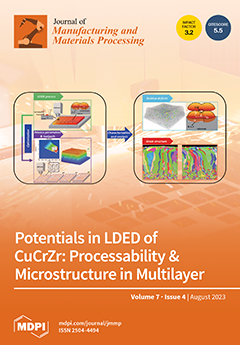This research addresses the challenge of determining the optimal parameters for the selective laser sintering (SLS) process using thermoplastic polyurethane elastomer (TPU) flexa black powder to achieve high-quality SLS parts. This study focuses on two key printing process parameters, namely layer thickness and
[...] Read more.
This research addresses the challenge of determining the optimal parameters for the selective laser sintering (SLS) process using thermoplastic polyurethane elastomer (TPU) flexa black powder to achieve high-quality SLS parts. This study focuses on two key printing process parameters, namely layer thickness and the laser power ratio, and evaluates their impact on four output responses: density, hardness, modulus of elasticity, and time required to produce the parts. The primary impacts and correlations of the input factors on the output responses are evaluated using response surface methodology (RSM). A particular response optimizer is used to find the optimal settings of input variables. Additionally, the rationality of the model is verified through an analysis of variance (ANOVA). The research identifies the optimal combination of process parameters as follows: a 0.11 mm layer thickness and a 1.00 laser power ratio. The corresponding predicted values of the four responses are 152.63 min, 96.96 Shore-A, 2.09 MPa, and 1.12 g/cm
3 for printing time, hardness, modulus of elasticity, and density, respectively. These responses demonstrate a compatibility of 66.70% with the objective function. An experimental validation of the predicted values was conducted and the actual values obtained for printing time, hardness, modulus of elasticity, and density at the predicted input process parameters are 159.837 min, 100 Shore-A, 2.17 MPa, and 1.153 g/cm
3, respectively. The errors between the predicted and experimental values for each response (time, hardness, modulus of elasticity, and density) were found to be 4.51%, 3.04%, 3.69%, and 2.69%, respectively. These errors are all below 5%, indicating the adequacy of the model. This study also comprehensively describes the influence of process parameters on the responses, which can be helpful for researchers and industry practitioners in setting process parameters of similar SLS operations.
Full article





